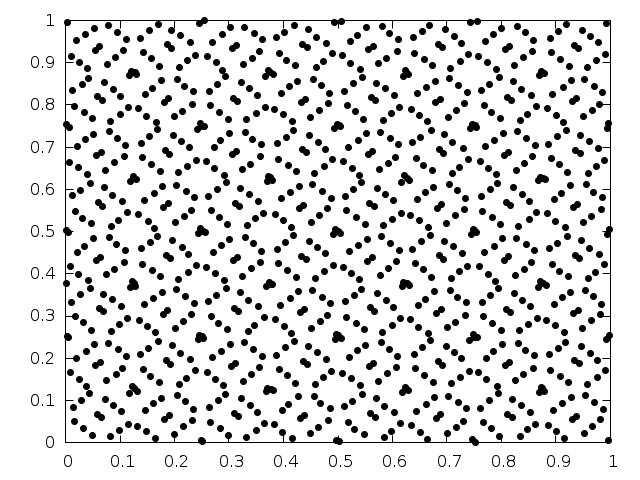Quasi-Random Sequences¶
This chapter describes functions for generating quasi-random sequences
in arbitrary dimensions. A quasi-random sequence progressively covers a
 -dimensional space with a set of points that are uniformly
distributed. Quasi-random sequences are also known as low-discrepancy
sequences. The quasi-random sequence generators use an interface that
is similar to the interface for random number generators, except that
seeding is not required—each generator produces a single sequence.
-dimensional space with a set of points that are uniformly
distributed. Quasi-random sequences are also known as low-discrepancy
sequences. The quasi-random sequence generators use an interface that
is similar to the interface for random number generators, except that
seeding is not required—each generator produces a single sequence.
The functions described in this section are declared in the header file
gsl_qrng.h.
Quasi-random number generator initialization¶
-
type gsl_qrng¶
This is a workspace for computing quasi-random sequences.
-
gsl_qrng *gsl_qrng_alloc(const gsl_qrng_type *T, unsigned int d)¶
This function returns a pointer to a newly-created instance of a quasi-random sequence generator of type
Tand dimensiond. If there is insufficient memory to create the generator then the function returns a null pointer and the error handler is invoked with an error code ofGSL_ENOMEM.
Sampling from a quasi-random number generator¶
-
int gsl_qrng_get(const gsl_qrng *q, double x[])¶
This function stores the next point from the sequence generator
qin the arrayx. The space available forxmust match the dimension of the generator. The pointxwill lie in the range for each
for each  . An inline version of this function is used when
. An inline version of this function is used when HAVE_INLINEis defined.
Auxiliary quasi-random number generator functions¶
-
const char *gsl_qrng_name(const gsl_qrng *q)¶
This function returns a pointer to the name of the generator.
-
size_t gsl_qrng_size(const gsl_qrng *q)¶
-
void *gsl_qrng_state(const gsl_qrng *q)¶
These functions return a pointer to the state of generator
rand its size. You can use this information to access the state directly. For example, the following code will write the state of a generator to a stream:void * state = gsl_qrng_state (q); size_t n = gsl_qrng_size (q); fwrite (state, n, 1, stream);
Saving and restoring quasi-random number generator state¶
Quasi-random number generator algorithms¶
The following quasi-random sequence algorithms are available,
-
type gsl_qrng_type¶
-
gsl_qrng_type *gsl_qrng_niederreiter_2¶
This generator uses the algorithm described in Bratley, Fox, Niederreiter, ACM Trans. Model. Comp. Sim. 2, 195 (1992). It is valid up to 12 dimensions.
-
gsl_qrng_type *gsl_qrng_sobol¶
This generator uses the Sobol sequence described in Antonov, Saleev, USSR Comput. Maths. Math. Phys. 19, 252 (1980). It is valid up to 40 dimensions.
-
gsl_qrng_type *gsl_qrng_halton¶
-
gsl_qrng_type *gsl_qrng_reversehalton¶
These generators use the Halton and reverse Halton sequences described in J.H. Halton, Numerische Mathematik, 2, 84-90 (1960) and B. Vandewoestyne and R. Cools Computational and Applied Mathematics, 189, 1&2, 341-361 (2006). They are valid up to 1229 dimensions.
-
gsl_qrng_type *gsl_qrng_niederreiter_2¶
Examples¶
The following program prints the first 1024 points of the 2-dimensional Sobol sequence.
#include <stdio.h>
#include <gsl/gsl_qrng.h>
int
main (void)
{
int i;
gsl_qrng * q = gsl_qrng_alloc (gsl_qrng_sobol, 2);
for (i = 0; i < 1024; i++)
{
double v[2];
gsl_qrng_get (q, v);
printf ("%.5f %.5f\n", v[0], v[1]);
}
gsl_qrng_free (q);
return 0;
}
Here is the output from the program:
$ ./a.out
0.50000 0.50000
0.75000 0.25000
0.25000 0.75000
0.37500 0.37500
0.87500 0.87500
0.62500 0.12500
0.12500 0.62500
....
It can be seen that successive points progressively fill-in the spaces between previous points.
Fig. 4 shows the distribution in the x-y plane of the first 1024 points from the Sobol sequence,

Fig. 4 Distribution of the first 1024 points from the quasi-random Sobol sequence¶
References¶
The implementations of the quasi-random sequence routines are based on the algorithms described in the following paper,
P. Bratley and B.L. Fox and H. Niederreiter, “Algorithm 738: Programs to Generate Niederreiter’s Low-discrepancy Sequences”, ACM Transactions on Mathematical Software, Vol.: 20, No.: 4, December, 1994, p.: 494–495.